THE FARMS LINES OF BROOKLYN (1874)
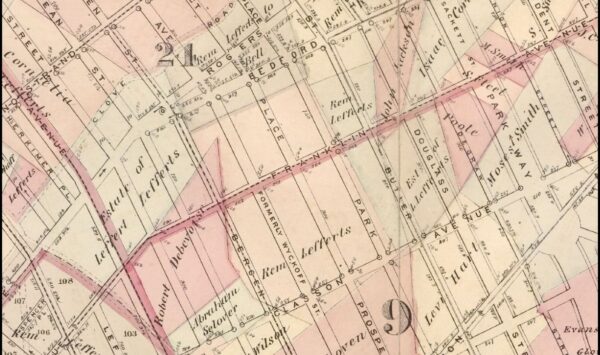
******************************************************************************************************************************** Brownstone Detectives investigates the history of our clients’ homes. The story you are about to read was composed from research conducted in the course of one of those investigations. Do you know the history of YOUR house? ******************************************************************************************************************************** Brooklyn was once one giant farm. At some point, as the farms began to be split up to be sold to developers – those who wanted to build rows of prized brownstones – companies also began to pop up which developed maps showing what types of buildings existed on every “lot” within the city. Although no longer used for fire insurance purposes, they are great tools for those owners wishing to research the histories of their properties. If you own a home in New York City, these maps can help you to determine how old it is, what else had been built in the area when your house was new, and, on some maps, the name of the farmer that had once owned your land. Find yours HERE. Follow @BrownstoneDetec Share ———————————————————————————————————————– The Brownstone Detectives Brownstone Detectives is an historic property research agency. Our mission is to document and save the histories of our clients’ homes. From our research, we produce our celebrated House History Books and House History Reports. Contact us today to begin discovering the history of your home.
SELLING WHISKEY TO SOLDIERS (1918)
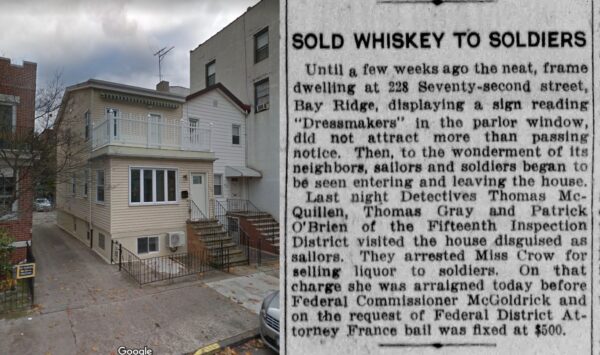
******************************************************************************************************************************** Brownstone Detectives investigates the history of our clients’ homes. The story you are about to read was composed from research conducted in the course of one of those investigations. Do you know the history of YOUR house? ******************************************************************************************************************************** “Until a few weeks ago the neat, frame dwelling at 228 Seventy-second street, Bay Ridge, displaying a sign reading “Dressmakers” in the parlor window did not attract more than a passing notice. Then, to the wonderment of its neighbors, sailors and soldiers began to be seen entering and leaving the house. Last night Detective Thomas McQuillen, Thomas Gray and Patrick O’Brien of the Fifteenth Inspection District visited the house disguised as sailors. They arrested Miss Crow for selling liquor to soldiers. On that charge she was arraigned today before Federal Commissioner McGoldrick and on the request of Federal District Attorney France bail was fixed at $500. Follow @BrownstoneDetec Share ———————————————————————————————————————– The Brownstone Detectives Brownstone Detectives is an historic property research agency. Our mission is to document and save the histories of our clients’ homes. From our research, we produce our celebrated House History Books and House History Reports. Contact us today to begin discovering the history of your home.
SNUFFED OUT IN A BOWERY WINE CELLAR (1917)
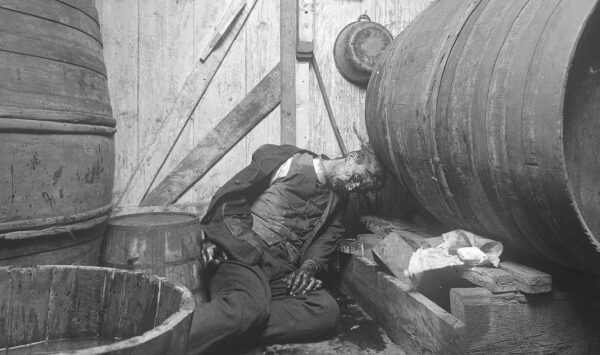
******************************************************************************************************************************** Brownstone Detectives investigates the history of our clients’ homes. The story you are about to read was composed from research conducted in the course of one of those investigations. Do you know the history of YOUR house? ******************************************************************************************************************************** When we discovered a set of NYPD archive photographs showing the aftermath of a murder in the wine cellar of a Bowery tenement, it came attached with just a street address as a clue. Armed with this information, we started our investigation, tracking down the story of the murder from newspaper archives. We present that story – and these original pictures – to you today. This brief story details exactly what allegedly happened and how the subject came to be discovered murdered in his wine cellar. The story is from the New York Tribune of Friday, 19 January 1917. – The Brownstone Detectives “The telephone bell in Dominick Bononeolo’s undertaker’s shop, at 294 Elizabeth Street, rang at 7:30 last night. The undertaker himself responded in his soothing tones. “‘Go down cellar,’ commanded a harsh masculine voice, ‘and see that everything is well with Dominick.’ “The undertaker tried to explain that an hour before he had seen Dominick Maestropaolo descend into his wine cellar beneath the undertaker’s shop and that he had seemed in the best of health. The telephone had gone dead, however, except for central’s thin query. “Bononeolo’s son, Giuseppe, who is about twenty year old, went down. One of the iron doors was open. A flickering gas flame set […]
IN GOWANUS, AMONGST COCAINE FIENDS (1914)
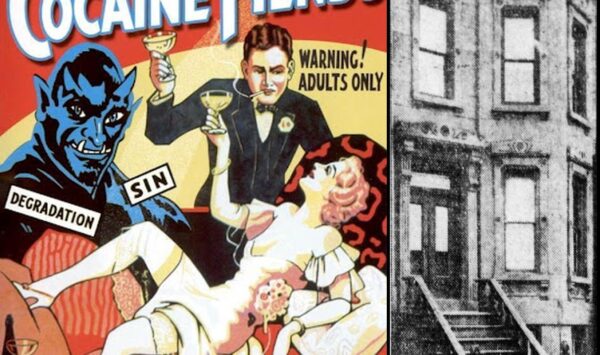
******************************************************************************************************************************** Brownstone Detectives investigates the history of our clients’ homes. The story you are about to read was composed from research conducted in the course of one of those investigations. Do you know the history of YOUR house? ******************************************************************************************************************************** Cocaine abuse truly became a “thing” in the United States starting in the early 20th century. Although it existed here earlier than that, it wasn’t until the early 1900s that states began to prick up their ears to the threat and counter its effects on society. In 1910, President William Taft declared the white powder “Public Enemy No. 1,” and in 1914, where our story begins, Congress passed the Harrison act, which tightly regulated the distribution and sale of cocaine. That year, an unassuming brownstone in the less-than-glitzy Gowanus neighborhood in Brooklyn became the target, first, of wealthy cocaine users and then, second, the police. SAY WEALTHY FOLK GOT COCAINE HERE “Detectives Asip and Dowd, of the Bergen street station, made a raid at the two-story and basement brownstone house at 666 Degraw street late yesterday afternoon,” noted the Brooklyn Daily Eagle, “and arrested a man and a woman for selling and dealing in cocaine, heroin and opium. “The attention of the police had been called to the place by some neighbors. The frequent presence of automobiles, carriages and other vehicular equipment of well-to-do persons at the front door aroused suspicion. “Detectives Asip and Dowd got a tip which led them to believe that the occupants of the house were dealing […]
THE MARXIST AT No. 477 E. 16th St. (1910)
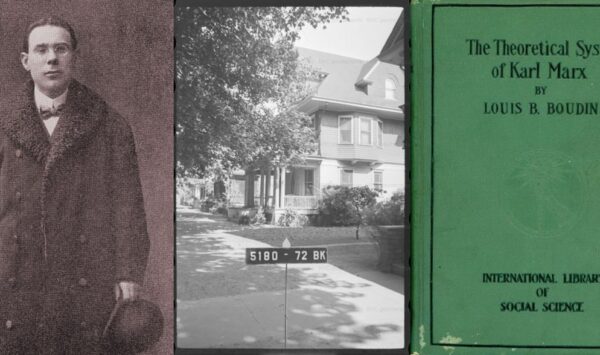
******************************************************************************************************************************** Brownstone Detectives investigates the history of our clients’ homes. The story you are about to read was composed from research conducted in the course of one of those investigations. Do you know the history of YOUR house? ******************************************************************************************************************************** At No. 477 East Sixteenth Street lived a Socialist. He wasn’t your ordinary, run-of-the-mill Socialist, however. Louis B. Boudin was a Russian-born American Marxist theoretician, writer, politician, and lawyer, who wrote a two volume history of the Supreme Court’s influence on American government as well as his piece de resistance, The Theoretical System of Karl Marx in the Light of Recent Criticism, first published in 1907. Boudin’s family emigrated to America in June 1891 and settled in New York City. He worked in the garment industry as a shirt maker and as a private tutor. At the same time, Boudin began legal studies, gaining a Master’s Degree from New York University and being admitted to the New York State Bar Association in 1898. At first, Boudin was a member of the Socialist Labor Party of America. He was also a member of the governing National Executive Board of the party’s trade union affiliate, the Socialist Trade and Labor Alliance from 1898 to 1899. Although he left the party for a short period, he returned after the turn of the century, being elected a delegate of the Socialist Party of America of the International Socialist Congress in Stuttgart in 1907 and the 1910 Copenhagen Congress of the Second International. Boudin was frequently […]
PAINTING THE HUDSON AT No. 75 ST. JAMES PL
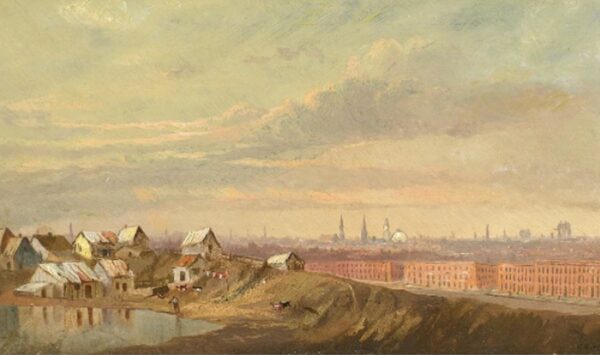
******************************************************************************************************************************** Brownstone Detectives investigates the history of our clients’ homes. The story you are about to read was composed from research conducted in the course of one of those investigations. Do you know the history of YOUR house? ******************************************************************************************************************************** Charles Day Hunt was a talented landscape painter whose work pivoted between the naturalism of the Hudson River School and the expressionism of the Tonalists. Born in Detroit, Michigan, in 1840, he eventually settled in Brooklyn, New York, around 1858 and trained under the landscape painters of the day: John F. Kensett and Alexander Wyant. Hunt’s exhibitions of oil and water color works took place from his studio at No. 75 St. James Place in Clinton Hill section of Brooklyn. Hunt’s work seamlessly blends the influences of both of his mentors in an individual style of crisp brilliance and atmospheric moodiness. Beginning in 1866 going through 1886, Hunt exhibited many times at The National Academy of Art & Design and The Brooklyn Academy of Art. He gained prominence as a member of The Black & White Club, which was a private American art association. Hunt died in 1914 in Brooklyn where, in his studio, his funeral was held. The body lay “beside the empty studio chair, pulled up before the easel,” noted the Brooklyn Daily Eagle, “on which was the picture Mr. Hunt had been working on before his seizure; the palette and oil colors were still wet.” Today, his works can be found in private and public collections, including The Brooklyn Museum […]
BURGLAR-ON-A-SHELF, No. 1141 DEAN ST (1911)
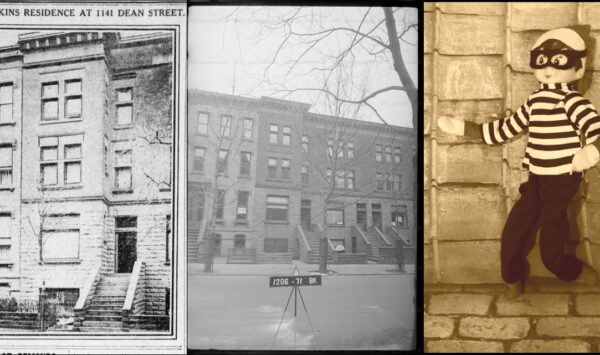
******************************************************************************************************************************** Brownstone Detectives investigates the history of our clients’ homes. The story you are about to read was composed from research conducted in the course of one of those investigations. Do you know the history of YOUR house? ******************************************************************************************************************************** Nearly a month after Christmas of 1910, a daring brownstone burglary occurred. (Or, at least, it was thought to have come to pass.) The incident took place in a fashionable neighborhood of Brooklyn – where such acts are rarely mentioned (outside of the servants). The burglar was never discovered, although a large number of police reserves and detectives had responded to the call and combed the house and the neighborhood. The police never solved the crime – nor did they even prove that it had ever taken place. But their presence on the upper-crust street caused quite the hubbub where many upstanding residents lived – many of whom feared their residence would be the next target. NOW YOU SEE ME, NOW YOU DON’T “The police of the Grand avenue station are to-day stil investigating the circumstance surrounding the calling out of the reserves and detectives to 1141 Dean street, the residence of J. C. Hipkins,” noted the Brooklyn Daily Eagle on 21 January 1911. Hipkins, whose full name was John Clifton Hipkins, was an insurance broker who lived in a “fashionable” neighborhood, the residents of which, the Eagle said, were “still agitated over the occurrence, which transpired about 5 o’clock Thursday afternoon. “The Hipkins residence,” the paper continued, “is just across […]
No. 4 EAST 78th ST, UES: A BRIEF HISTORY
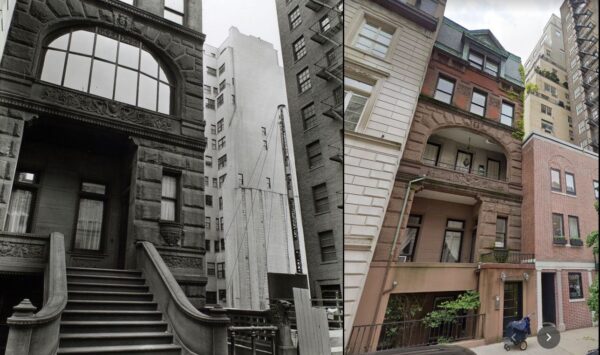
******************************************************************************************************************************** Brownstone Detectives investigates the history of our clients’ homes. The story you are about to read was composed from research conducted in the course of one of those investigations. Do you know the history of YOUR house? ******************************************************************************************************************************** According to Christopher Gray’s Streetscapes: Reader’s Questions, of the New York Times, No. 4 East 78th Street, is a Queen Anne-style house “built in 188 by the developer-architect Edward Kilpatrick. Upon completion, Kilpatrick sold it to the family of Arnold Falk, then living in a rowhouse at 129 East 64th. Mr. Falk was in the tobacco business on Water Street with his brother, Gustav, who lived in an adjacent house, 131 East 64th. On East 78th, Mr. Falk lived with his wife, Fannie, their two children and four servants. In the 1910’s and the 1920’s the house was occupied by the family of Jacob Dreicer, a principal in the Dreicer & Company jewelry firm founded in 1869, which was prominent in this period. There are now seven apartments in the building.” (New York Times, Sunday, 2 June 1991) Follow @BrownstoneDetec Share ———————————————————————————————————————– The Brownstone Detectives Brownstone Detectives is an historic property research agency. Our mission is to document and save the histories of our clients’ homes. From our research, we produce our celebrated House History Books and House History Reports. Contact us today to begin discovering the history of your home.
THE RAREBIT FIEND OF 23 MIDDAGH ST (1906)
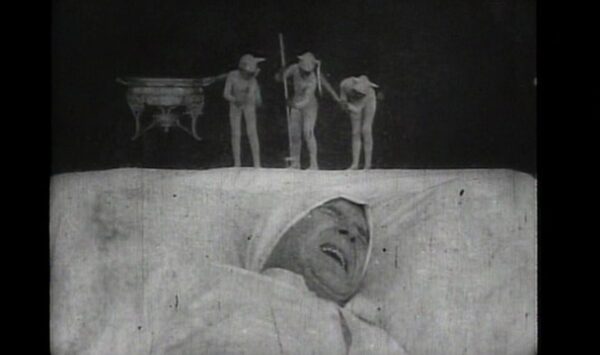
******************************************************************************************************************************** Brownstone Detectives investigates the history of our clients’ homes. The story you are about to read was composed from research conducted in the course of one of those investigations. Do you know the history of YOUR house? ******************************************************************************************************************************** At No. 23 Middagh Street in Brooklyn Heights, in the early 20th century, lived the veteran actor, John P. “Jack” Brawn, who starred in upwards of 24 motion pictures. Most notably, he starred in the first ever trick motion picture, 1906’s “The Dream of a Rarebit Fiend.” Brawn lived on Middagh with his wife, Ethel Brooke Ferguson, who had been his leading lady on stage and whom he married in 1903. THE DREAM A trippy movie, “The Dream of a Rarebit Fiend” is about a man, played by John P. Brawn, the titular “fiend,” who has an all-too-real dream after consuming a large meal of Welsh Rarebit. His dream, rather a nightmare – the result of an upset stomach, the film implies – was likely supposed to represent the penance that could expect to be paid for the sin of gluttony connected with living a life of overabundance. The director of the short film, Edwin S. Porter, based the film on a comic strip, using it as a vehicle to present his mastery of the technical aspects of film-making, which displayed a good deal of hands-on special effects work – double exposures, miniatures and other camera trickery. Few cinema-goers, it is certain, would have seen a picture like this at the time. […]
THE PAINTED LADY OF SACKETT STREET (1958)
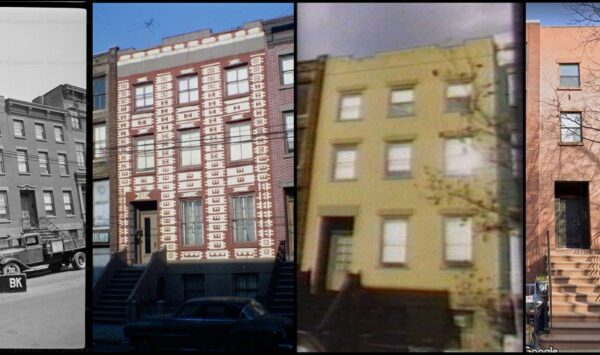
******************************************************************************************************************************** Brownstone Detectives investigates the history of our clients’ homes. The story you are about to read was composed from research conducted in the course of one of those investigations. Do you know the history of YOUR house? ******************************************************************************************************************************** Houses as old as the historic brownstones of New York City have had a lot of time to experience change – change of ownership, change of status, as well as physical change. Much of that change often occurs on the inside of these buildings as their occupancy type changes. The most prevalent change of this type that occurs over time is the change of a property from a single family house to a mutiple dwelling or boarding house. Just outside the Cobble Hill Historic District, sits a much-altered brownstone on Sackett Street between Court and Clinton Streets, No. 275. Constructed pre-1855 as a one-family house it would experience many change over the years. Its original address was No. 160. Its original owner appears to have been William H Perry, a stock broker on Wall Street. By the 1860s, the Forsyth family lived in the Sackett Street rowhouse. Orlando Forsyth was a jeweler who, in the 1840s, had had a showroom on Fulton Street at No. 99. The house would begin taking boarders in the 1870s, continuing at least through most of the 20th century. THE LADY GETS A FACELIFT At face, however, the physical changes of No. 275 seem to be the most striking. While, in its original state, it resembled […]